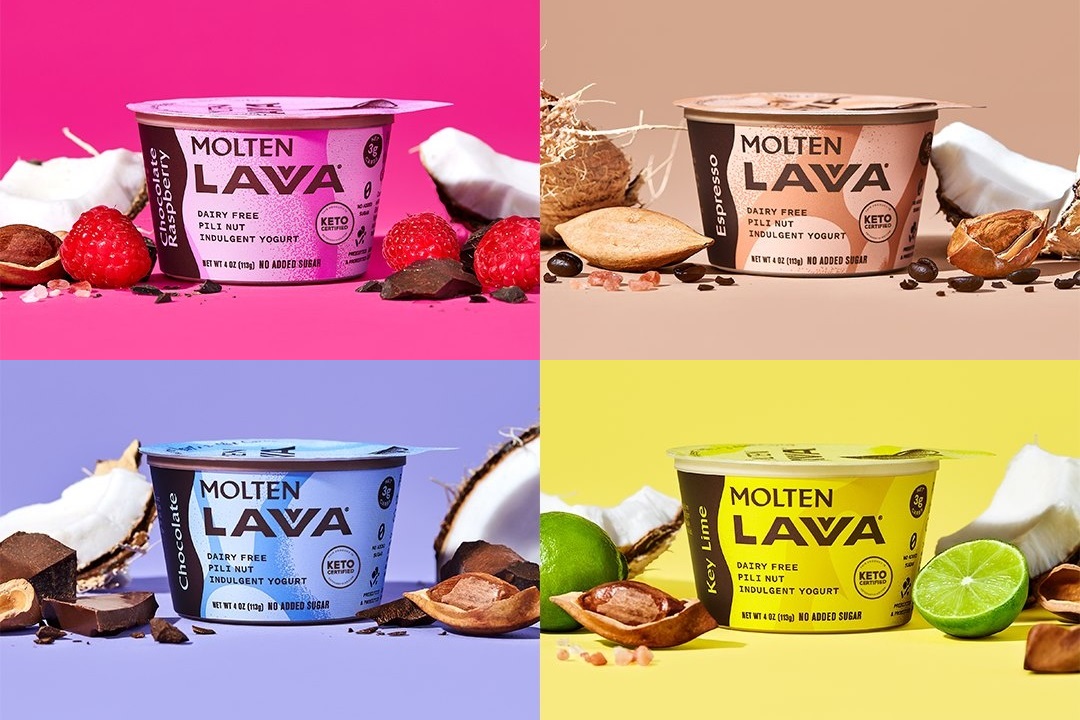
It’s rare that non-dairy yogurt signals indulgence. That slimy-thin texture, courtesy of carrageenan and naturally-low fat alt-milk can too easily taste like a health halo booby prize. But blend up some pili nuts and coconut -- as Brooklyn’s non-dairy yogurt brand Lavva does -- and you’ve got a product worth analyzing.
While the pili nut is making in-roads at specialty food fairs, its mainstream star has yet to explode. Here’s what you need to know: they’re quite mild, have a sweet taste and are a bit like a macadamia nut, only creamier. That’s because they’re really high in fat (per 100 grams, they have four more grams of fat than macadamias do). Pili nuts are native to Southeast Asia and Northern Australia, but when sold commercially they’re usually cultivated in the Philippines. Some companies are starting to make pili nut butter, but it’s way too rich to swap for peanut butter in a lunchbox-friendly sandwich.
These properties are part of the reason why Lavva’s new dessert-inspired dairy-free yogurt line is such a shrewd move. In May, Lavva released Molten Lavva and, silly name aside, I’m betting it will increase their sales and share of the alt-yogurt market. Not only does the original’s naturally sweet flavor and rich, nutty texture lend it a whiff of dessert, the non-dairy yogurt’s higher-than-average price point begets the one-off treat that comes with a post-meal indulgence.
To avoid negative associations with the now-maligned sweetened yogurt category, Lavva chose to have this line Keto certified. That means it’s high in fat and ultra-low in carbs. Instead of sugar, it’s sweetened with erythritol, a sugar alcohol, and monkfruit extract, a plant-based sweetener. The alt-yogurt also contains chicory root to add fiber and reduce the yogurt’s net carb count (here’s how to read a label to see if it’s keto). There’s also a bunch of coconut cream in there, an easy way to bulk up the product and prevent the pili nuts from pushing the mixture into pudding territory. All of this it to say the nutritional facts have been meticulously curated and third-party verified (via the Keto certification) to ensure sweet flavors like Key Lime Pie and Chocolate don’t get passed over as Yoplait 2.0 (also known as, there’s more sugar where that came from).
To further prove the product’s alignment with today’s health concerns, Molten Lavva is fortified with vegan probiotics. On one hand, the probiotics reinforce the alt-yogurt’s association with traditional yogurt, which has a reputation as a good source for gut-friendly bacteria. Yet the demand for probiotics has skyrocketed since the pandemic on the assumption that immunity is linked to good gut health (I write about this here). Combined with consumers’ current zeal for ultra-high-fat yogurt, which as Priya Krishna argues on The Goods is becoming a race to blur the boundaries between ice cream and breakfast, the probiotics bolster Molten Lavva image as a have-when-you-want snack.
This chameleonic appeal will be crucial to the product’s success. While consumers were opting to fuel their days via a selection of snack-sized meals before work-from-home orders, this habit has supercharged during quarantine. And it’s likely to continue as major companies continue to suspend in-office working. With the dissolution of mealtimes comes the dissolution of foods linked to certain times of day. If you’re not having breakfast per se, why can’t your morning meal taste like pie? And if you’re not having lunch at one, why not just have a cup of yogurt to hold you over through your next Zoom call? This flexi-eating style means that products that blend together multiple benefits -- in this case sweetness, high-fat, plant-based probiotics -- will grab consumers who think about their diet in terms of overall benefits, not set meals.
While I don’t love the name, I expect Lavva’s dessert-leaning Molten line to be a hit with East Coast consumers. The product is indulgent, but the brand has taken care to ensure that every on pack claim works to position the alt-yogurt as an anytime-treat in the shoppers mind. By letting the product appeal to both keto-adherents and vegans, Lavva captures a wide swath of what it means to be healthy in 2020. There consumers are also more likely to splurge on diet-specific foods, making the product’s relatively high price point a bridgeable gap. Furthermore, the product fits into the daily patterns of how consumers eat by mixing together breakfast and dessert into a single container that’s apt for anytime.
_____
Fun Fact: A new study from Kroger and the Plant Based Food Association found that alt-meats sell 23% better when placed in the regular meat section. My first reaction was: obviously, didn’t we already see that with alt-milks? Beyond that, I think there are a few motivating factors that make this finding not quite the surprise it wants to be. The first is that people who want these products don’t want to travel half-way around the store to get them (if they can even find where they are), the second is that people who are buying these products likely just heard about them on TV and are treating them as an impulse buy, and finally, they’re probably meat eaters who are either getting duped and think they’re buying beef/pork or are curious to try this novel product they heard about on TV. The real question we should be asking ourselves is, why are we letting the meat and milk lobbies keep alt-products from the refrigerated cases when it’s clear that consumers want them there?